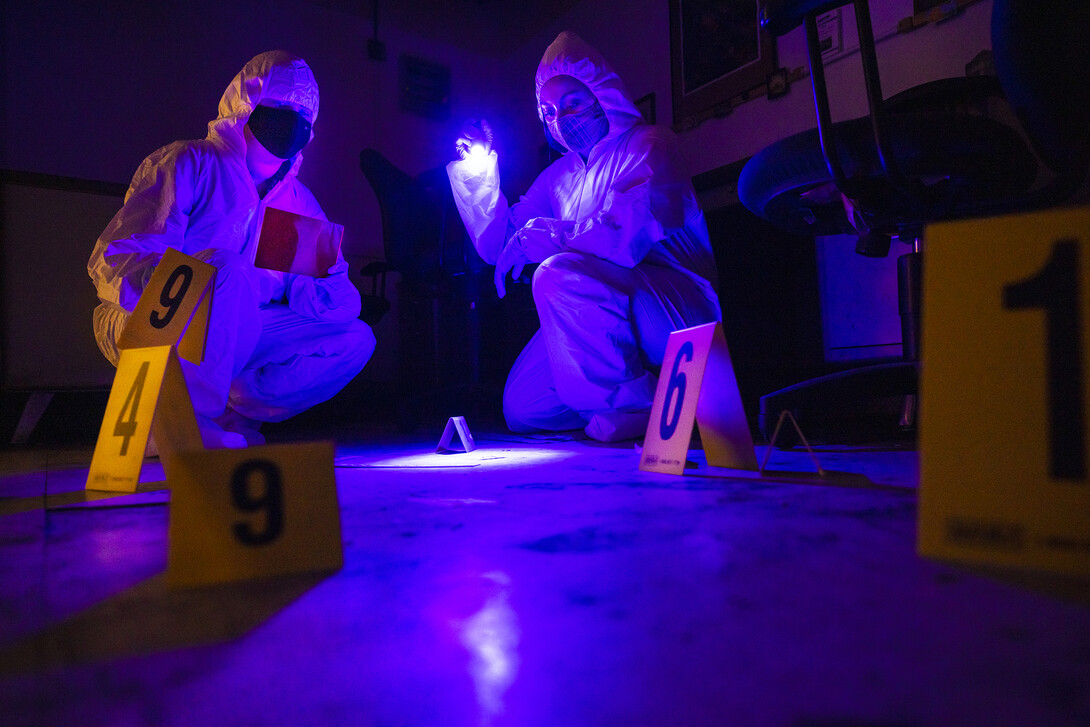
There was a murder in the basement of Filley Hall this semester — or at least, the staging of a homicide crime scene. Signs of struggle were obvious. A desk chair was tipped over. Blood was splattered and items and substances were strewn about. What happened?
Students in the University of Nebraska–Lincoln’s Forensic Science Capstone class opened UNLFL Case #2021-0001, and began an investigation. They spent the better part of spring semester meticulously processing the scene, examining evidence, conducting laboratory tests and testifying in mock court.
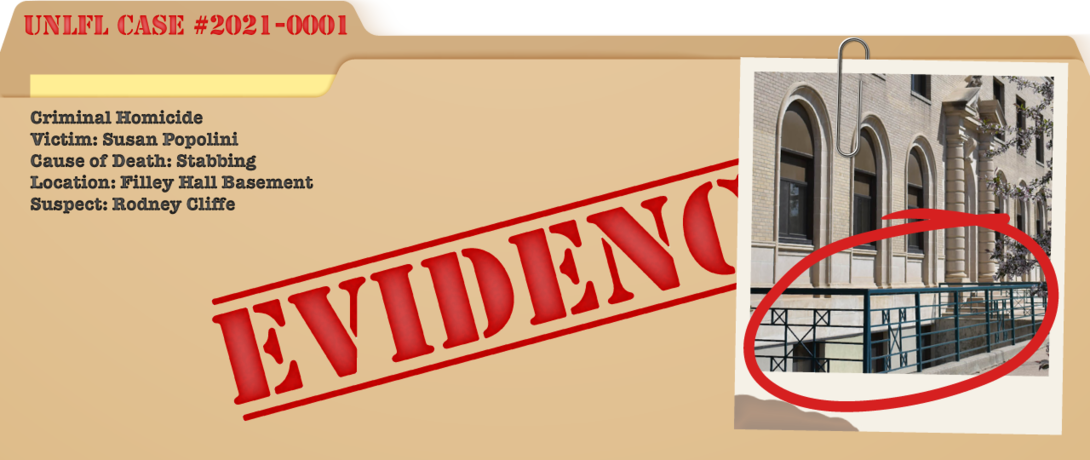
The capstone course is a culmination of everything they’ve learned in the major, said Michael Adamowicz, director of the program. And, despite the COVID-19 pandemic, the instructors were able to safely teach the course in person this semester.
“We kind of blend in certain aspects throughout their entire previous three and a half years and prep them for what's coming,” Adamowicz said. “We’ve made the class mimic the kind of training they’ll experience as a forensic analyst, when they join a lab.”
The course started with about three weeks of lecture, diving into such topics as testimony, forensic science professional ethics, career preparation (including resume or CV development), and public speaking.
Following the in-classroom lectures, the students were broken into three groups, based on their forensic science track, or emphasis — crime scene investigation, biology and chemistry — and the investigatory work began.
“In the capstone, we’re using everything we’ve learned,” said Abby Lutz, a senior forensic science major with a chemistry track. “In the course, you actually start to use all your skills, and you learn the processes of checking out evidence, making sure your chain of custody is right, using evidence worksheets — none of this we’ve done previously — and we cap it off with the testimony.”
The crime scene
In a room in Filley Hall, Adamowicz, along with co-instructors Larry Barksdale, assistant professor of practice, and Molly Reil, assistant professor of practice, set the scene of a chaotic homicide.
“Miss Susan Popolini was unfortunately murdered, the prime suspect is Rodney Cliffe, and there’s detection of a random janitor,” Adamowicz said. “The janitor is what’s called an elimination — someone who was detected in the area, had access, and has to be eliminated as a suspect. This is very common in real crime scenes. You’re going to have people who were in the area, but had nothing to do with the crime.”
The victim, played by a crime scene dummy, was stabbed. There were unknown substances, a (presumed) bloody sock, fingerprints, and footprints, among other evidence.
“We have one of our crime scene dummies, as the decedent, which had blood spatter stains for analysis,” Adamowicz said. “We had a pocket knife with a broken tip that was found. There was material spilled on the floor and on the desk. It's a fairly small room, and we stuffed a lot into it.”
Students in the crime scene investigation track processed the scene. Donning hazmat suits, safety glasses and booties, they worked throughout the room, finding fingerprints, looking for blood, gathering items as evidence and taking photographs.
The students kept detailed records as they went, documenting what they found and where, and the chain of evidence.
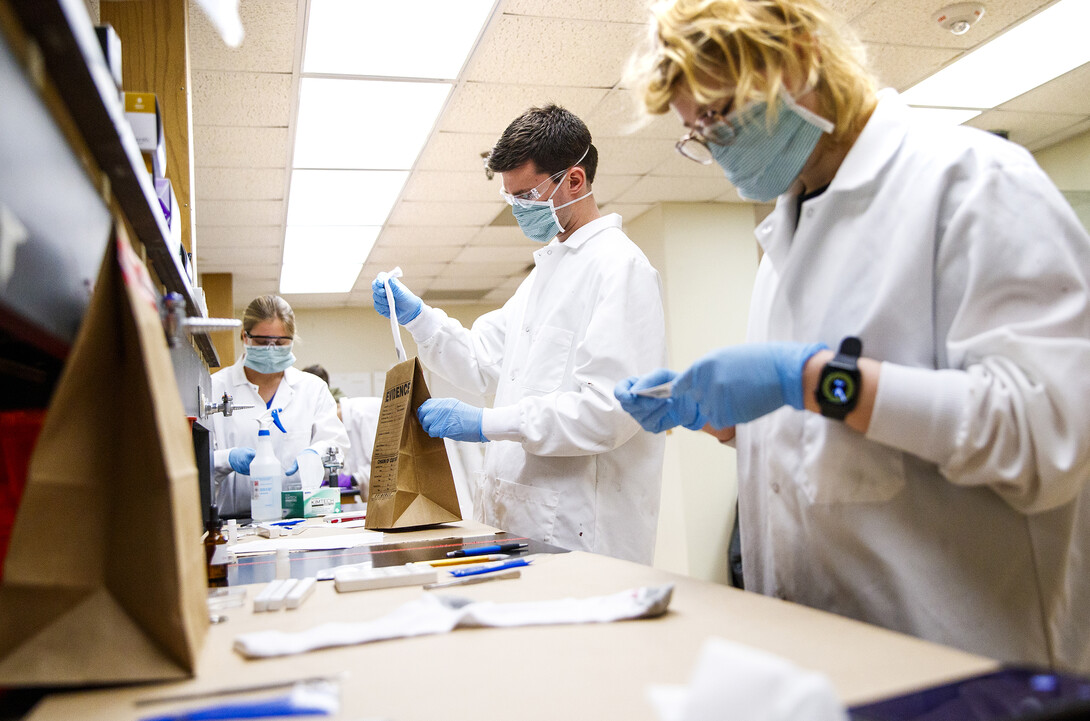
In the lab
While the CSI students were doing their work, the biology and chemistry students ran testimony drills with Adamowicz. After the evidence was collected from the scene, the biology- and chemistry-track students took the wheel of the investigation.
In the University of Nebraska–Lincoln Crime Lab, the students kept diligent logs and records of each class time as they went through the process of identifying substances, including blood, and running analyses.
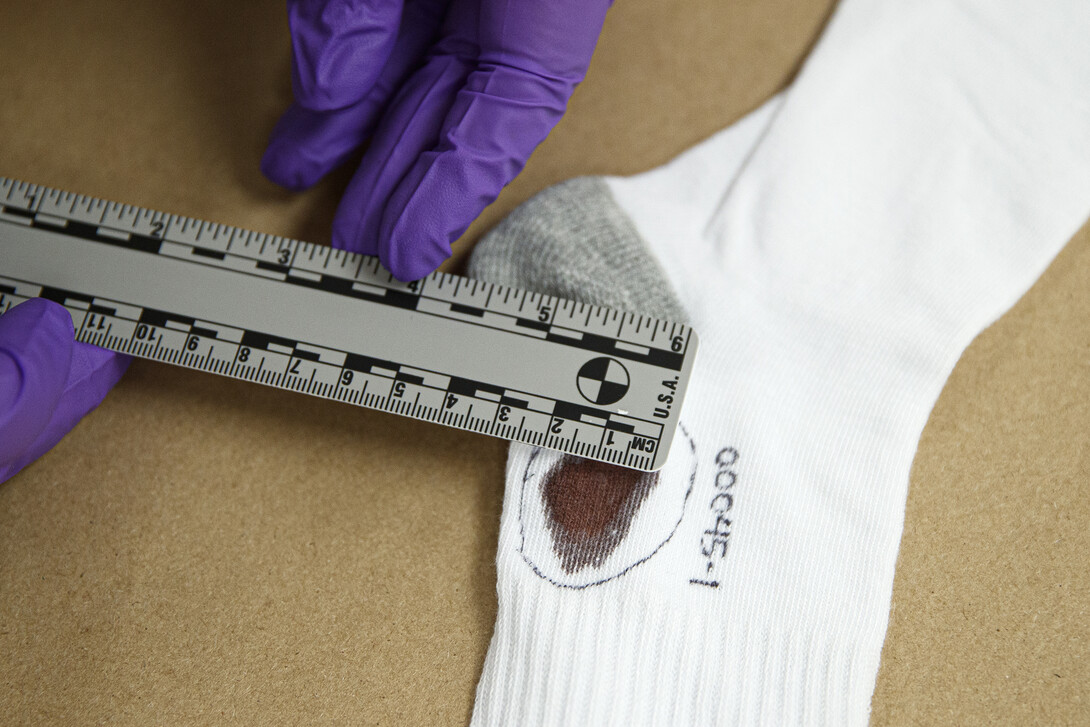
The biology students worked with three human samples of DNA, including the bloody sock. Adamowicz supplied the blood for the sock through an arrangement with his own doctor’s office. The other samples were swabs from the co-instructors.
“It's all real human stuff — it has to be,” Adamowicz said. “There’s about six weeks of actual scientific bench testing. A big chunk of this semester is hands-on laboratory work.”
While the biology students extracted the DNA, chemistry-track students were in charge of processing the unknown substances found at the scene. They analyzed pills, a green leafy substance and a white powder.
“All of these may or may not be controlled substances in a real-life scenario,” Adamowicz said. “For class, we used over-the-counter medications, and household items like oregano, salt, sugar and baking powder, but these things are nice analogs for things like marijuana and cocaine.”
Lutz said her crime lab experience felt true to life.
“For the white powder, we got to do chemical spot testing, with various reagents to see what it reacted to, and what that was consistent with,” Lutz said. “We used microscopy. We also have an instrument called the FTIR, or Fourier-transform infrared spectroscopy, in the lab, and none of us had really used that before, so it was really beneficial to have that interaction with that instrument.”
Each student created reports from their analyses, which would eventually end up in front of them during testimony.
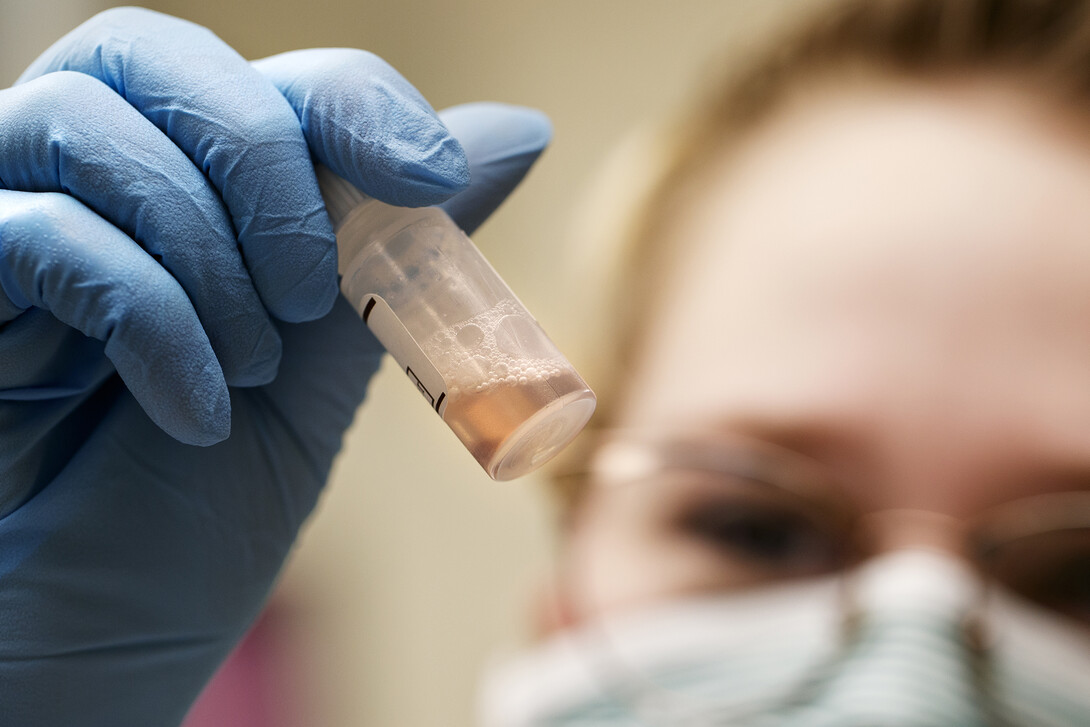
In (mock) court
The semester ended with about three weeks of mock trial, when each of the 18 students testified in direct and cross examinations. The co-instructors served as the prosecutors and defense attorneys, according to their own specialty.
“Doing the mock testimony was interesting,” Lutz said. “It was nerve-wracking, but it was fun. It was extremely helpful.”
Adamowicz said this portion of the class is as important — if not more so — as the in-field and lab work.
“It draws everything together,” he said. “It draws on all of their technical skills, their presentation skills, and helps identify for them what they need to work on.”
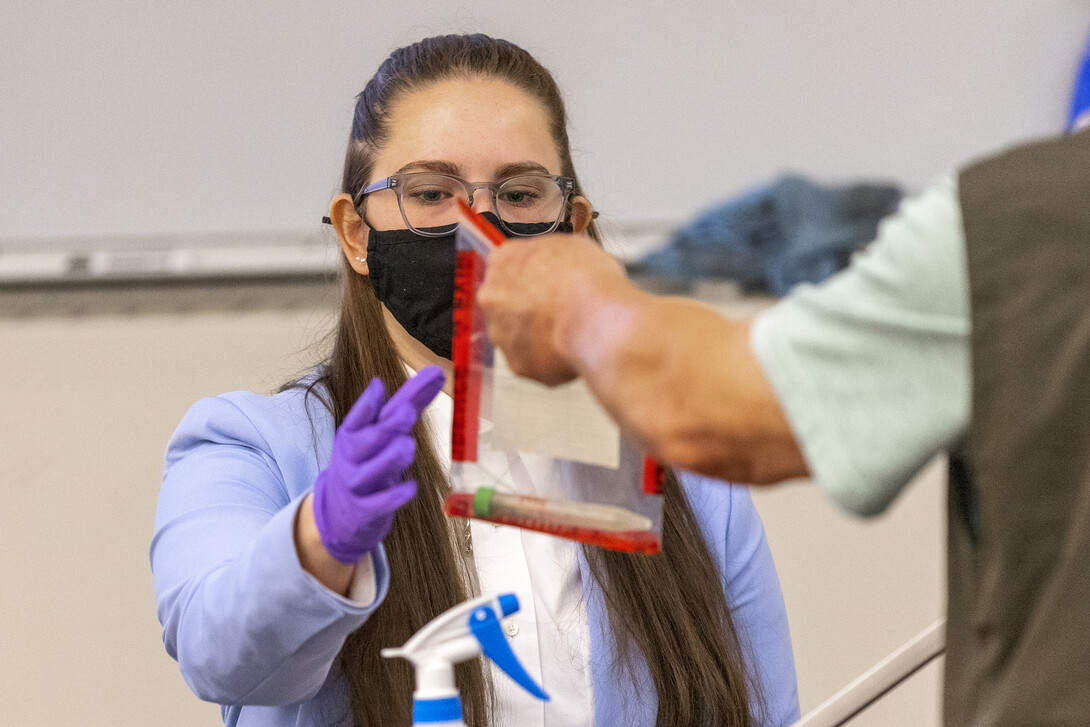
And the cross examination is meant to be tough.
“No forensic analyst ever goes to real court without practicing many times,” Adamowicz said. “A supervisor has to sign off on a trainee before they’re ever in court. Mistakes are very costly, so your analysts have to be trained harder than the real thing will be.”
During cross, the instructors often drilled down into the language used during the testimony — with good reason.
“I’m immediately going to jump in (in cross) if they didn’t define a word or phrase, because it is something you must do in court,” Adamowicz said. “We spent three and a half, four years teaching the students highly technical material, and by the end, we have our own, nearly incomprehensible language. We can’t use that in court because a jury will never understand, so I make sure during testimony that each student can really define those terms. We practice until they can do that.”
Meanwhile, the students not testifying served as jurors. Instead of determining guilt or innocence, they evaluate their peers’ testimony.
“We have students fill out evaluations and give those back to students so hopefully they get some constructive comments,” Adamowicz said. “Because this is the first time they have ever done anything like this, it’s helpful to know what they did well and not so well from the perspective of jurors listening.”
This semester’s class looked a little different. In the past, the mock trial has been held in the courtroom of the College of Law, but due to pandemic restrictions, that wasn’t possible.
“We had to be spread out, so we moved it to a classroom auditorium in Filley,” Adamowicz said. “Normally, we’d have all our jurors seated together, and the judge would sit at their bench. The courtroom also adds some theatricality to it — it feels like you’re really testifying.”
The capstone course also will look different in 2022, with the addition of the crime scene house, which is a property the university acquired in 2016, adjacent to and north of East Campus. The house has undergone renovations to make it usable as a crime scene for a variety of classes. There are also outdoor spaces, which have been utilized while renovations were ongoing, including a car crime scene, and areas for learning how to gather evidence through excavation, and for the study of decomposition.
“The crime scenes will be staged in the house, and that opens up a number of possibilities,” Adamowicz said. “I think it will add to the immersive feeling and to the education of our students because they’ll be in a house, with different rooms and items to process.”
Crime & Capstone by University of Nebraska–Lincoln on Exposure







